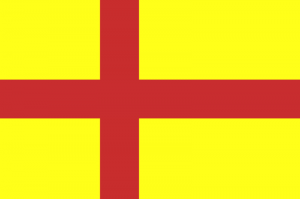term paper abstract, winter semester 2004/2005, Potsdam university by Lars Dittmer
the Nordic cross in Great Britain – the unofficial flag of the Orkney Islands arouses astonishment in the watcher and gives him an idea of how Orcadians feel – being a Scandinavian, and being British. The flag shows the red Norwegian cross on a yellow background, symbolizing the Scottish Royal flag (cf. Towrie 1996-2005: FAQ). Scandinavian culture and self-image still constitute a part of identity in parts of Scotland – especially in Shetland and Orkney, collectively named the Northern Islands. Here, this cultural background has over centuries found expression through a Scandinavian language, called Norn, Icelandic norœnna, the Norwegian language (Fenton 1997: 617).
This term paper is to document the historical and cultural circumstances in which a Scandinavian language could develop in Northern Scotland, its nature and prevalence during its era, and finally, its demise and the remains of Norn in today’s language in Orkney. The paper attaches importance to the fact that it is on the one hand power constellations and politics that produce linguistic changes such as the death of a language, but on the other hand also requires “the active participation of its former speakers” (Barrett 2003: 98). The paper almost exclusively focuses on the development on the Orkney Islands, taking into consideration that history as well as the language itself differs to some extent on the Shetland Islands.
Development and Demise of Orkney Norn – a peace of
Scandinavian Culture in Great Britain
Table of Contents
1. General Introduction
1.1 Introduction: the Nordic cross in Great Britain
1.2 General facts about Orkney
2. History and Language
2.1 Pre-Norse Orkney
2.2 The Pictish-Norse transition
2.3 The Vikings and their language
2.4 Norn
2.5 “Scottization” – the demise of Orkney Norn
3. Language in Orkney today
3.1 The remnants of Norn
3.2 The Orcadian dialect
3.3 discussion/ outlook
4. Bibilography
1. General Introduction
1.1. Introduction: the Nordic cross in Great Britain
The unofficial flag of the Orkney Islands arouses astonishment in the watcher and gives him an idea of how Orcadians feel – being a Scandinavian, and being British. The flag shows the red Norwegian cross on a yellow background, symbolizing the Scottish Royal flag (cf. Towrie 1996-2005: FAQ). Scandinavian culture and self- image still constitute a part of identity in parts of Scotland – especially in Shetland and Orkney, collectively named the Northern Islands. Here, this cultural background has over centuries found expression through a Scandinavian language, called Norn, Icelandic nor(?)nna, the Norwegian language (Fenton 1997: 617).
This term paper is to document the historical and cultural circumstances in which a Scandinavian language could develop in Northern Scotland, its nature and prevalence during its era, and finally, its demise and the remains of Norn in today’s language in Orkney. The paper attaches importance to the fact that it is on the one hand power constellations and politics that produce linguistic changes such as the death of a language, but on the other hand also requires “the active participation of its former speakers” (Barrett 2003: 98). The paper almost exclusively focuses on the development on the Orkney Islands, taking into consideration that history as well as the language itself differs to some extent on the Shetland Islands.
1.2 General facts about Orkney
Orkney1 is an archipelago of about 70 islands lying ten kilometres off the north coast of Scotland in the North Sea. The 2001 census provided a total number of 19, 245 people inhabiting less than one third of the islands. The major part of the population lives in the two main towns Kirkwall, the administrative centre of Orkney, and Stromness, both being located on “Mainland”, the largest island of the archipelago. Of further importance are the islands Hoy and South Ronaldsay in the south of Scapa Flow, and some minor islands in the north such as Sanday or Westray. People are mainly employed in agriculture and tourism. Since the 1970s, North Sea oil contributes to the income of the Orcadians. Since the 1990s, however, flows from this industry have decreased (Leyden 2004: 11).
2. History and language
2.1 Pre-Norse Orkney
Today, there is no exact knowledge about the question when first human life came to Orkney. Nevertheless, there is evidence that the islands have provided human habitat for at least five and a half thousand years (Ritchie 1990: 36). Preserved constructions from these days such as the Ring of Brodgar, a large stone circle, and Maes Howe, a chambered tomb on Mainland, show that people in the Neolithic era were skilful stone-builders (Ritchie 1990: 39). Identity and language of the Picts, a tribe that settled in mainland Scotland and the Northern Islands from around 300 BC to the Norse settlements, have remained subject to dispute until today.
(…)
Continue reading on Hausarbeiten.de or contact me

